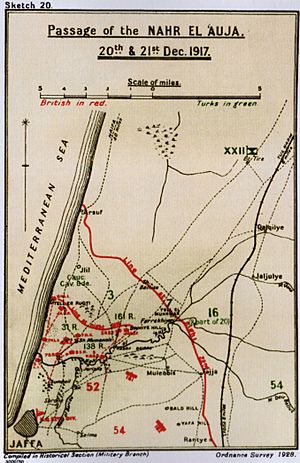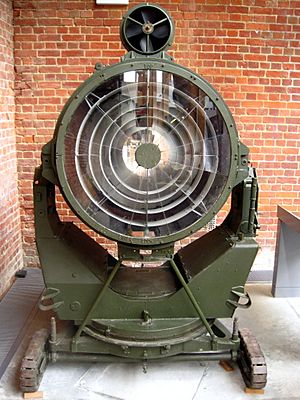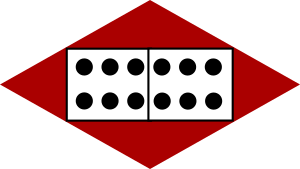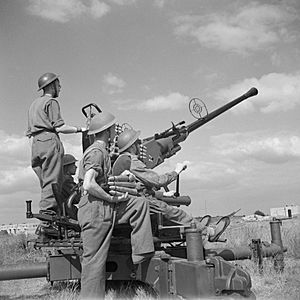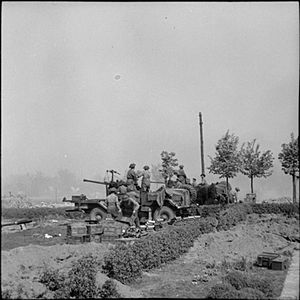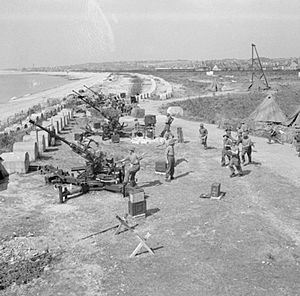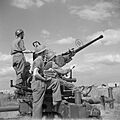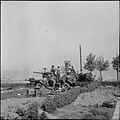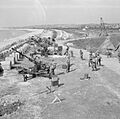4th (Glasgow, 1st Northern) Lanarkshire Rifle Volunteer Corps facts for kids
Quick facts for kids 4th (Glasgow, 1st Northern) Lanarkshire RVC8th Bn, Cameronians (Scottish Rifles) 57th (Cameronians) Searchlight Rgt, RA 147th (Glasgow) Light Anti-Aircraft Rgt, RA 592nd (Glasgow) Light Anti-Aircraft Rgt, RA |
|
|---|---|
| Active | 10 October 1859 – 12 May 1950 |
| Country | |
| Branch | |
| Role | Infantry Air Defence |
| Part of | 52nd (Lowland) Division 65th (2nd Lowland) Division 3rd Anti-Aircraft Division 12th Anti-Aircraft Division 47th (London) Division |
| Garrison/HQ | Glasgow |
| Engagements | Second Boer War Gallipoli Campaign Sinai and Palestine Campaign Western Front The Blitz Operation Diver |
The 4th (Glasgow, 1st Northern) Lanarkshire Rifle Volunteer Corps was a Scottish Volunteer unit of the British Army. It was first formed in Glasgow in 1859. Later, it became a battalion of the Cameronians (Scottish Rifles).
During World War I, this unit fought in the Gallipoli Campaign, where it suffered huge losses. It also served in Egypt and Palestine and on the Western Front. Before World War II, it changed its role to an anti-aircraft regiment. It continued to defend against air attacks throughout World War II and into the years after the war, until 1950.
Contents
How the Unit Started
In 1859, many people were worried about a possible invasion. This led to the creation of many Rifle Volunteer Corps (RVCs). These were groups of part-time soldiers who wanted to help the regular British Army.
One of these groups was the 4th (Glasgow, 1st Northern) Lanarkshire RVC. It started in Glasgow with just one company. On 10 October 1859, the army officially accepted its service. Soon after, on 12 December 1859, it joined with several other RVCs from Glasgow. This made it a full battalion with different companies:
- A Company, from the original 4th (Glasgow, 1st Northern) Lanarkshire RVC.
- B Company, from the 6th Lanarkshire RVC.
- C Company, from the 7th Lanarkshire RVC.
- D Company, from the 8th Lanarkshire RVC.
- E Company, from the 12th (North Eastern) Lanarkshire RVC. This company was made up of workers from Tennent's Wellpark Brewery.
- F Company, from the 13th Lanarkshire RVC, from the St Rollox area.
The battalion kept its unique name, 'Glasgow, 1st Northern', for many years. In July 1861, three more companies joined. These were Highland companies, meaning their soldiers wore kilts:
- G Company, from the 60th (Glasgow, 1st Highland) Lanarkshire RVC.
- H Company, from the 61st (Glasgow, 2nd Highland) Lanarkshire RVC.
- I Company, from the 93rd (Glasgow Highland Rangers) Lanarkshire RVC.
In 1868, about 187 Highland soldiers moved from these companies to a new unit, the 105th (Glasgow Highlanders) RVC. The three companies then changed their uniforms, wearing tunics and trews instead of kilts.
The battalion's main office was first at 138 Stirling Street in Glasgow. Later, it moved to 149 Cathedral Street. They also had a rifle range nearby for training.
Becoming Part of a Larger Regiment
In 1872, the army made changes to how units were organized. The 4th Lanarkshire RVC was grouped with other regiments in the Lanarkshire area.
Then, in 1881, more changes happened. The 4th Lanarkshire RVC became a Volunteer Battalion of the new Cameronians (Scottish Rifles) regiment. On 1 December 1887, it officially became the 4th Volunteer Battalion of the Cameronians.
In 1888, a new plan was introduced for Volunteer units. They would gather in special brigades during wartime. In peacetime, these brigades helped with training. The Lanarkshire battalions, including the 4th, became part of the Clyde Brigade, later called the Glasgow Brigade.
In 1893, the Kelvinside Academy Cadet Corps was formed. This was a youth training group linked to the battalion.
Seventy-three volunteers from the battalion fought in the Second Boer War. Most of them served in special volunteer companies of the Scottish Rifles. Their service earned the battalion its first Battle honour: South Africa 1900–02. This is a special award for bravery in battle.
In 1902, the Glasgow Brigade was split up. The four Volunteer Battalions of the Cameronians then formed the Scottish Rifle Brigade.
Joining the Territorial Force
In 1908, the Volunteers became part of a new army group called the Territorial Force (TF). The battalion then became the 8th Battalion, Cameronians (Scottish Rifles). The Kelvinside Academy Cadet Corps became part of the Officers' Training Corps (OTC) for young people. The Scottish Rifles Brigade was part of the Lowland Division of the TF.
World War I Service
Getting Ready for War
In August 1914, the Lowland Division was at its yearly training camp when the order to get ready for war came. The 8th Scottish Rifles gathered at 149 Cathedral Street in Glasgow. They then guarded important places around Glasgow and the River Clyde.
By 10 August, the division was ready and moved to its war locations. The 8th Battalion was in Larbert with the Scottish Rifles Brigade at Falkirk. Soldiers stayed in various buildings.
On 10 August, units were asked if they wanted to serve overseas. Most soldiers agreed. To replace them, a second group of units, called '2nd Line' units, was created. These units had the same names but with a '2/' prefix. This way, duplicate battalions were formed to send overseas. If there were enough new recruits, '3rd Line' units were also formed.
1/8th Scottish Rifles in Action
The 1/8th Scottish Rifles was told to prepare for overseas service in April 1915. They received new rifles and equipment. On 7 May, they learned they would go to the Gallipoli Campaign. They got sun helmets and water carts.
On 11 May, the division was named the 52nd (Lowland) Division. The Scottish Rifles became the 156th (Scottish Rifles) Brigade. The 1/8th Scottish Rifles, led by Lt-Col H. Monteith Hannan, boarded a troopship called Ballarat on 18 May. They arrived at Mudros on 29 May.
Fighting at Gallipoli
While at Mudros, some soldiers from the battalion went ashore to help keep order. The rest of the battalion sailed to Cape Helles on 13 June. They landed at V Beach and joined the 29th Division. They faced some attacks from Turkish artillery.
On the night of 18/19 June, they took over the front line. On 21 June, their commander, Lt-Col Hannan, was killed by a sniper. The battalion was relieved on 24/25 June.
The battalion returned to the front line on 27 June and took part in the Battle of Gully Ravine on 28 June. After a heavy bombardment, the attack began at 11:00. The 1/8th Scottish Rifles had to attack trenches H12 and H12A. They had some grenades, but most did not work. The brigade had no artillery support.
The soldiers were packed into their starting trenches and suffered heavy losses from enemy shells before they even attacked. When they went "over the top" at 11:02, they were "simply mown down." Few men reached the enemy lines. The battalion's acting commander said, "Five minutes after they had started they were practically wiped out."
The battalion lost 14 officers and 334 soldiers killed or missing. Many also died when dry grass caught fire. The next morning, only 3 officers and 70 men were left. They temporarily joined with another battalion.
During July and August, the weakened battalion continued to serve. On 15 November, they made another attack and suffered more losses. They finally received some new soldiers on 1 December. The battalion was evacuated from Gallipoli on 8 December. Their ship, HMS Prince George, was hit by a torpedo, but it did not explode.
Moving to Egypt
After the 7th/8th Scottish Rifles left, the entire Gallipoli force was evacuated. The 52nd (Lowland) Division moved to Egypt. The two battalions became separate again on 21 February.
In March 1916, they took over part of the Suez Canal defenses. On the night of 3/4 August, German and Turkish forces attacked their position in the Battle of Romani. The attack was stopped by British artillery. The battle continued, but the pursuit was difficult in the desert.
Fighting in Palestine
By the end of 1916, the army in Egypt was ready to invade Palestine. This started the Sinai and Palestine Campaign. The 52nd (Lowland) Division was kept in reserve during the 1st Battle of Gaza in March 1917.
In the 2nd Battle of Gaza on 19 April, the 1/8th Scottish Rifles attacked Mansura. They were pinned down for hours and suffered losses from shellfire. The battle ended on 20 April. The 1/8th Scottish Rifles lost 2 officers and 30 soldiers killed, and many more wounded or missing.
For months, the division dug defenses and faced constant small attacks. In the autumn of 1917, a new commander, Sir Edmund Allenby, took charge. The 3rd Battle of Gaza (31 October–7 November) was much more successful. The 52nd (Lowland) Division helped by holding the enemy's attention. The 1/8th Scottish Rifles supported another unit in attacking strong enemy positions. The Turks retreated, and the division chased them.
The army then advanced towards Jerusalem. The 52nd (Lowland) Division had to move through difficult terrain in heavy rain. They helped in the Battle of Nebi Samwil. The Turks launched a counter-attack in late November, but the British line held. On 11 December, the army captured Jerusalem.
The next big operation for the 52nd (Lowland) Division was crossing the Nahr el Auja. This led to the Battle of Jaffa. On the night of 20 December, in heavy rain, the 156th Brigade crossed the river. The Royal Engineers helped get more soldiers across on rafts.
The 1/8th Scottish Rifles then moved east through a muddy orange grove. They captured "Keystone House" and the Turkish headquarters, getting behind enemy lines. By 06:00, the battalion was digging in. The Turks were completely surprised and retreated. The advance continued on 22 December. The 52nd (Lowland) Division reached the castle of Arsuf. Crossing the Auja was called "one of the most remarkable feats of the Palestine Campaign." The 8th Scottish Rifles had only 8 casualties.
Fighting on the Western Front
In early 1918, the 52nd (Lowland) Division moved to the Western Front in France. The 1/8th Battalion arrived at Marseilles on 17 April. The division gathered near Abbeville and trained. On 6 May, they moved to the Vimy area and took over front line trenches.
On 28 June 1918, the 8th Scottish Rifles joined the 103rd Brigade in the 34th Division. This division had suffered heavy losses and was being rebuilt. The 103rd Brigade now included three Scottish battalions.
The 34th Division was sent to help the French army. When the Germans attacked on 15 July (the Second Battle of the Marne), the division was sent to Senlis. By 23 July, they had taken over the front line near Soissons.
The 34th Division immediately joined the French counter-attack on 23 July, but it failed. By 29 July, the division was ready to attack again and capture Beugneux Ridge. On 1 August, the 103rd Brigade attacked. The 8th Scottish Rifles supported them. Despite heavy losses, the battalion pushed forward. The ridge was captured the next day.
The 34th Division then moved to the Ypres Salient to rest and train. They helped capture Mont Kemmel. On 28 September, the 34th Division attacked in the Fifth Battle of Ypres. The 103rd Brigade took its first objective. They used their Lewis guns to overcome enemy resistance and captured Wytschaete Ridge.
The division was in reserve until the Battle of Courtrai. On 14 October, the 103rd Brigade attacked Geluwe. Three companies of the 8th Scottish Rifles encircled the village. They then moved on to take other objectives. By the end of the day, the brigade reached the River Lys. One company tried to cross that night but was pinned down and suffered heavy losses.
The river was crossed elsewhere, and the advance continued on 19 October. The battalion's last battle was the Battle of Tieghem on 31 October. The 34th Division attacked with French forces. The 103rd Brigade attacked at 05:25, supported by French tanks. They reached their first objective quickly.
Two companies of the 1/8th Scottish Rifles reached Anseghem. They moved around the village to the south, while another company cleared the village with French tanks. The enemy retreated during the night. The 8th Scottish Rifles pushed forward and occupied the hills north and south of Boshkant. Their patrols continued to advance, and the artillery attacks for the morning were cancelled. The 103rd Brigade chased the Germans to the Scheldt river.
After this, the 34th Division rested and trained until the Armistice with Germany on 11 November. Key soldiers were sent home. On 17 January 1919, the division moved to the Rhine river in Germany. They became part of the British Army of the Rhine. The remaining soldiers were sent home over time. The 1/8th Battalion was officially disbanded on 24 October 1919.
Other Battalions
- 2/8th Scottish Rifles: This second-line battalion was formed in Glasgow in September 1914. It was part of the 65th (2nd Lowland) Division. In November 1915, it combined with another battalion.
- 3/8th Scottish Rifles: This third-line reserve battalion was formed in Glasgow between November 1914 and March 1915. It later became the 8th Reserve Bn, Scottish Rifles, and then merged into the 5th Reserve Bn.
- 11th Provisional Battalion: In 1915, soldiers from the 8th Scottish Rifles who were only fit for Home Service (not overseas) joined this battalion. It moved to Kent in April 1916 for coastal defense. In 1917, it became the 11th Bn Royal Scots Fusiliers.
Between the World Wars
After World War I, the Territorial Force was reformed in 1920. The 8th Cameronians reformed in Glasgow. However, on 26 August 1921, it merged with the 5th Cameronians. It became the 5th/8th Battalion The Cameronians (Scottish Rifles) in the new Territorial Army (TA). This battalion was part of the 156th (Scottish Rifles) Brigade.
Becoming an Anti-Aircraft Unit
In the 1930s, Britain needed better air defense for its cities. Many TA infantry battalions were changed into anti-aircraft (AA) units. The 5th/8th Cameronians was one of these. It became a Royal Artillery searchlight (S/L) regiment in late 1938.
Because the TA was growing, two regiments were formed on 1 November 1938:
- 5th Bn Cameronians (Scottish Rifles) (56th Searchlight Regiment)
- 8th Bn Cameronians (Scottish Rifles) (57th Searchlight Regiment)
The 8th Battalion (as 57th S/L Rgt) now had its own identity again. Both regiments were part of 3 AA Division, which covered Scotland.
World War II Service
Getting Ready for War
In February 1939, Britain's air defenses were put under a new group called Anti-Aircraft Command. In June, some TA units began to mobilize, taking turns to man anti-aircraft and searchlight positions. On 24 August, just before war was declared, AA Command was fully ready at its war stations. The 8th Cameronians (57th S/L Rgt) became part of 52nd Light Anti-Aircraft Brigade. This brigade was in charge of all searchlights in 3 AA Division.
57th (Cameronians) Searchlight Regiment
During the early part of the war, there were some attacks on naval bases in Scotland. In August 1940, the regiment was officially named 57th (8th Battalion, Cameronian Scottish Rifles) Searchlight Regiment, RA.
Scotland did not face many air attacks during the Battle of Britain. But then, the German air force (Luftwaffe) started night attacks on British cities. This was known as The Blitz. In November 1940, a new 12 AA Division was formed for western Scotland, including Glasgow. The 57th S/L Regiment moved to 63 AA Brigade.
At this time, searchlights were arranged in groups of three to light up enemy bombers better. One light in each group would eventually get radar. Glasgow and Clydeside suffered heavy air raids on 13 and 14 March 1941 (the Clydebank Blitz), and again on 7 April. The Luftwaffe returned on 5 and 6 May before the Blitz ended.
The regiment provided experienced soldiers to help form a new battery, 544 S/L Bty, in December 1940. This new battery later joined the 88th S/L Rgt. The 57th S/L Regiment stayed in 63 AA Brigade throughout 1941.
By 1942, AA Command had enough searchlight units but needed more light anti-aircraft (LAA) gun units. So, searchlight units began to change roles. On 23 January, 57th S/L Rgt was joined by 535 S/L Bty and 275 men from another regiment. In November, it moved to 42 AA Brigade in eastern Scotland, then to 57 AA Brigade in North West England.
147th (Glasgow) Light Anti-Aircraft Regiment
In early 1943, the 57th S/L Rgt changed to the LAA role. It became the 147th (Glasgow) LAA Rgt on 20 February. Some of its searchlight batteries became independent. New LAA batteries joined the regiment. The conversion finished on 6 April. By June, 496 LAA Bty also joined.
The new regiment returned to Britain in May for battle training. It was then sent to 49 AA Brigade in the London area. From 18 August, it defended important places like reservoirs and factories.
On 18 October, the regiment moved to Dorset to join 47th (London) Infantry Division. It was equipped with self-propelled (SP) Bofors 40 mm LAA guns. These guns were active in training around Chichester and on the Isle of Wight. In August 1944, 47th Division was broken up.
The 147th LAA Regiment returned to AA Command. It was deployed on the Sussex coast as part of Operation Diver. This operation defended against attacks by V-1 flying bombs (called 'Divers'). By the end of 1944, the V-1 threat to SE England decreased. Many soldiers from the regiment were sent to be retrained as infantry for fighting in Europe.
In January 1945, the regiment moved to 30 AA Brigade in North East England. It defended important places from North Shields to Billingham. These areas were threatened by V-1s launched from aircraft over the North Sea.
Independent Batteries
Some of the searchlight batteries from the 57th S/L Rgt became independent on 20 February 1943.
LAA/SL Batteries in Europe
420 and 421 Batteries helped form 1 to 6 LAA/SL Composite Batteries in May 1943. These batteries defended targets like airfields and harbours from low-level air attacks. They started deploying to Normandy shortly after D Day (6 June 1944).
As the army advanced, these batteries moved with them. They defended river crossings and liberated ports like Le Havre, Dieppe, and Antwerp. During the winter fighting, they continued to provide air defense. In March 1945, 2 LAA/SL Bty helped protect supply areas for the Rhine crossing. During the crossing, 6 LAA/SL Bty lit up and shot down a German plane attacking a bridge. 2 LAA/SL Bty also covered the bridging of the Elbe river, one of the last major operations.
S/L Batteries in the Mediterranean
422 and 535 Independent S/L Batteries went to the Mediterranean Theatre. They landed in Sicily after the Allied landings. By September 1943, they were defending bases in Sicily like Syracuse and Catania.
422 S/L Battery moved to Bari in December. The port had been badly attacked, and 25 AA Brigade was sent to strengthen its defenses. 422 Bty deployed 24 searchlights at nearby Barletta. By late 1944, 535 S/L Bty was defending the port of Livorno. There is a story that 422 S/L Bty provided "artificial moonlight" for night operations by Canadian troops. 422 Independent Searchlight Battery was disbanded on 24 August 1945, and 535 Battery on 15 April 1946.
After the War
After VE Day, the regiment gathered in the Birmingham area. While soldiers were being sent home, the regiment helped with farm work.
When the TA was reformed on 1 January 1947, the 147th LAA Rgt was temporarily put on hold. Its soldiers formed a new Regular Army regiment, which was later disbanded.
Meanwhile, the TA unit reformed in Glasgow on 1 January 1947 as the 592nd (Glasgow) LAA Rgt. It was part of 77 AA Brigade. On 12 May 1950, it merged into the 474th (City of Glasgow) Heavy AA Rgt. This ended the direct line of the 8th Cameronians. However, the 474th HAA Rgt later merged into another regiment, the 445th (Cameronians) LAA Rgt, which was descended from the 5th Bn Cameronians.
Uniforms and Badges
The early RVCs in 1859–60 had different uniforms, usually grey or green. In 1863, A–F Companies adopted scarlet tunics with green trim, Trews of Black Watch tartan, and blue shakoes (tall hats). The Highland Companies wore scarlet doublets with green trim, Black Watch tartan kilts, and blue Glengarry bonnets with black feathers.
In 1876, blue trousers replaced trews. In 1878, dark blue helmets replaced shakoes. After the Boer War, the battalion wore a drab (dull brown) service uniform. It had scarlet piping on the trousers and a brown felt hat with the Scottish Rifles badge and a black feather. Only officers wore the full Scottish Rifles uniform for formal events. This service uniform was used until 1908. Then, the battalion adopted the Rifle green uniform with dark green trim, like the Scottish Rifles.
Important Leaders
These people served as Honorary Colonel of the battalion:
- John Tennant, appointed 15 April 1863
- Sir Charles Tennant, 1st Baronet, appointed 22 December 1880
- Sir John Muir, 1st Baronet, who was the Lord Provost of Glasgow, appointed 14 November 1891
- Warden R. Maxwell, VD, a former commanding officer, appointed 27 February 1904 (he continued as Hon Col of 5th/8th Bn after World War I)
- Sir Steven Bilsland, 2nd Baronet, MC, (a former captain in 8th Bn) appointed 1 November 1938
Memorials
The Cameronians War Memorial in Kelvingrove Park, Glasgow, remembers all the regiment's battalions that fought in World War I. It was sculpted by Philip Lindsey Clark. There is also a plaque in Glasgow Cathedral for all the Cameronian soldiers who died in World War I.
Images for kids
More Information
- Mark Conrad, The British Army, 1914 (archive site)
- British Army units from 1945 on
- Imperial War Museum, War Memorials Register
- Great War Forum
- The Long, Long Trail
- Orders of Battle at Patriot Files
- The Regimental Warpath 1914–1918 (archive site)
- Land Forces of Britain, the Empire and Commonwealth – Regiments.org (archive site)
- Graham Watson, The Territorial Army 1947


